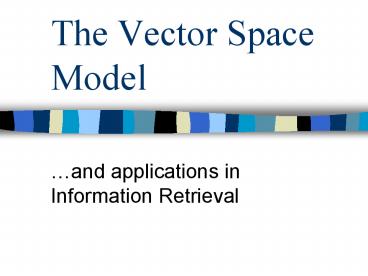The Vector Space Model - PowerPoint PPT Presentation
1 / 18
Title:
The Vector Space Model
Description:
a, and, cat, dog, frog. Example, continued. Document A: 'A dog ... frog. and. a. Queries. Queries can be represented as vectors in the same way as documents: ... – PowerPoint PPT presentation
Number of Views:251
Avg rating:3.0/5.0
Title: The Vector Space Model
1
The Vector Space Model
- and applications in Information Retrieval
2
Part 1
- Introduction to the Vector Space Model
3
Overview
- The Vector Space Model (VSM) is a way of
representing documents through the words that
they contain - It is a standard technique in Information
Retrieval - The VSM allows decisions to be made about which
documents are similar to each other and to
keyword queries
4
How it works Overview
- Each document is broken down into a word
frequency table - The tables are called vectors and can be stored
as arrays - A vocabulary is built from all the words in all
documents in the system - Each document is represented as a vector based
against the vocabulary
5
Example
- Document A
- A dog and a cat.
- Document B
- A frog.
6
Example, continued
- The vocabulary contains all words used
- a, dog, and, cat, frog
- The vocabulary needs to be sorted
- a, and, cat, dog, frog
7
Example, continued
- Document A A dog and a cat.
- Vector (2,1,1,1,0)
- Document B A frog.
- Vector (1,0,0,0,1)
8
Queries
- Queries can be represented as vectors in the same
way as documents - Dog (0,0,0,1,0)
- Frog ( )
- Dog and frog ( )
9
Similarity measures
- There are many different ways to measure how
similar two documents are, or how similar a
document is to a query - The cosine measure is a very common similarity
measure - Using a similarity measure, a set of documents
can be compared to a query and the most similar
document returned
10
The cosine measure
- For two vectors d and d the cosine similarity
between d and d is given by - Here d X d is the vector product of d and d,
calculated by multiplying corresponding
frequencies together - The cosine measure calculates the angle between
the vectors in a high-dimensional virtual space
11
Example
- Let d (2,1,1,1,0) and d (0,0,0,1,0)
- dXd 2X0 1X0 1X0 1X1 0X01
- d ?(2212121202) ?72.646
- d ?(0202021202) ?11
- Similarity 1/(1 X 2.646) 0.378
- Let d (1,0,0,0,1) and d (0,0,0,1,0)
- Similarity
12
Ranking documents
- A user enters a query
- The query is compared to all documents using a
similarity measure - The user is shown the documents in decreasing
order of similarity to the query term
13
VSM variations
14
Vocabulary
- Stopword lists
- Commonly occurring words are unlikely to give
useful information and may be removed from the
vocabulary to speed processing - Stopword lists contain frequent words to be
excluded - Stopword lists need to be used carefully
- E.g. to be or not to be
15
Term weighting
- Not all words are equally useful
- A word is most likely to be highly relevant to
document A if it is - Infrequent in other documents
- Frequent in document A
- The cosine measure needs to be modified to
reflect this
16
Normalised term frequency (tf)
- A normalised measure of the importance of a word
to a document is its frequency, divided by the
maximum frequency of any term in the document - This is known as the tf factor.
- Document A raw frequency vector (2,1,1,1,0), tf
vector ( ) - This stops large documents from scoring higher
17
Inverse document frequency (idf)
- A calculation designed to make rare words more
important than common words - The idf of word i is given by
- Where N is the number of documents and ni is the
number that contain word i
18
tf-idf
- The tf-idf weighting scheme is to multiply each
word in each document by its tf factor and idf
factor - Different schemes are usually used for query
vectors - Different variants of tf-idf are also used































